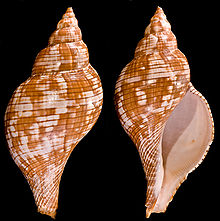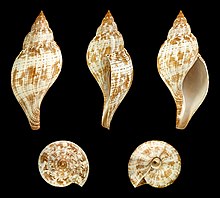Real tulip snail
| Real tulip snail | ||||||||||||
|---|---|---|---|---|---|---|---|---|---|---|---|---|

Fasciolaria tulipa fished out of the water |
||||||||||||
| Systematics | ||||||||||||
|
||||||||||||
| Scientific name | ||||||||||||
| Fasciolaria tulipa | ||||||||||||
| ( Linnaeus , 1758) |
The real tulip snail ( Fasciolaria tulipa ) is a species of snail from the family Fasciolariidae (genus Fasciolaria ) that is widespread in the western Atlantic . It feeds mainly on mollusks .
features
The right-handed, spindle-shaped snail shell of Fasciolaria tulipa , which in adult snails reaches a length of 6 to 24 cm, has about 9 convex whorls. The outer lip is thin and has five teeth on the inner edge. The surface of the shell is smooth and has very fine growth lines. The color can vary a lot. The house is creamy white, light brown, or reddish orange with irregular dark brown, white, or cream colored spots. Brown spiral lines run on the windings. The oval operculum is thick, heavy and has a terminal core.
The snail is bright orange to vivid red in color. Often the color is dark red-brown to gray-brown with white spots.
Occurrence
The real tulip snail can be found in the western Atlantic and in the Gulf of Mexico on the coast of America and in the Caribbean Sea from North Carolina ( USA ) to Brazil .
It lives in the intertidal zone and a little below on sand and in seagrass meadows, where it buries itself in the sediment at low tide.
Life cycle
Like other new snails, Fasciolaria tulipa is separate sexes, with the females being slightly larger. When mating , the female remains upright on the sand while the male turns around and turns his case mouth to that of the female and then mates the female with his penis . The union takes up to two hours, whereby the snails do not let themselves be disturbed by the ebb tide. Individual specimens copulate up to three times in a week. There is no fixed mating time in warm water. The females attach their clutches to a solid substrate, which can be a stone, a mollusc shell or seaweed. According to measurements in Florida , a clutch comprises 20 to 115 (on average 71) egg capsules that are attached to small stalks on a long ribbon. The capsules average about 18 mm high, 13.5 mm wide and 6.2 mm thick. One egg capsule contains around 600 to 800 eggs, around 14 of which develop into snails, while the others serve as food eggs. The development of the Veliger stage takes place in the egg capsule, so that finished snails hatch.
nutrition
The real tulip snail is a carnivore that feeds on snails and clams . The shell of the prey is broken with the mouth rim of the predator. It is an important predator of the great fencing snail ( Lobatus gigas ). There is also cannibalism. Young animals in particular also eat carrion, such as leftovers from mussels that have been left over by predators.
Enemies
An important enemy of the real tulip snail is the related, very large snail species Triplofus giganteus . Other enemies are stingrays and pubic crabs (genus Calappa ). The snail flees from enemies - similar to z. B. the whelk - by rolling over. However, a large Triplofusus giganteus that can slide quite quickly on its foot is catching up with a small tulip snail. The shell of the tulip snail that has been eaten empty is usually obtained very quickly by hermit crabs .
Importance to humans
The real tulip snail is collected for its shell, which is sold as jewelry. The meat is eaten raw or cooked.
Individual evidence
- ↑ Pam Walker, Elaine Wood: The Coral Reef . Life in the Sea Series, Facts on File, Infobase Publishing, New York 2009. p. 71.
- ↑ Fasciolaria tulipa (Linnaeus, 1758) True Tulip . Completely buried in clean sand, Mayport Naval Station beach, Jacksonville, Duval County, Florida 1/9/2009 (125 mm), jaxshells.org
- ^ Charles N. d'Asaro: Egg Capsules of Prosobranch Mollusks from South Florida and the Bahamas and Notes on Spawning in the Laboratory . In: Bulletin of Marine Science. 20 (2) 1970, pp. 414-440.
- ↑ J. Wendell Burger, Charles Stead Thornton: A Correlation between the food eggs of Fasciolaria tulipa and the apyrene spermatozoa of prosobranch molluscs . In: Biological Bulletin. 68 (2) 1935, pp. 253-257.
- ↑ Tulip Snails. True Tulip Fasciolaria tulipa, Banded Tulip Fasciolaria hunteria. In: EE Ruppert, RS Fox: Seashore Animals of the Southeast: A guide to common shallow-water invertebrates of the southeastern Atlantic coast . University of South Carolina Press, Columbia (South Carolina) 1988, p. 114.
- ↑ ES Iversen, EE Jory, SP Bannerot: Predation on queen conchs, Strombus gigas, in the Bahamas . In: Bulletin of Marine Science. 39 (1) 1986, pp. 61-75. (pdf)
- ^ A b F. E. Wells Jr .: An ecological study of two sympatric species of Fasciolaria (Mollusca: Gastropoda) in Alligator Harbor, Florida . Florida State University, 1969, pp. 95-108. (Veliger 13)
- ↑ BBC Earth: Giant Horse Conch and Burglar Hermit Crabs .
Web links
- Smithsonian Marine Station at Fort Pierce: Fasciolaria tulipa (Tulip Snail)
- jaxshells.org: Fasciolaria tulipa (Linnaeus, 1758) True Tulip (pictures)
- Fasciolariidae: Fasciolaria tulipa (Kiener, 1840) . From: José H. Leal: Gastropods . In: Kent E. Carpenter (Ed.): FAO Species identification guide for fishery purposes. The living marine resources of the Western Central Atlantic. Volume 1: Introduction, molluscs, crustaceans, hagfishes, sharks, batoid fishes and chimaeras. Food and Agriculture Organization of the United Nations, Rome 2002, p. 118.
- Fischhaus Zepkow: Family Fasciolariidae - tulips & spindles

